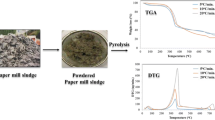Abstract
In this paper, conversion of paper sludge to ethanol was investigated with the objective of optimization of the overall operation costs. Experimental work was undertaken to optimize cellulase loading, and to determine mixing energy requirements. It was found that decreasing feeding frequency (feed additions per residence time) allows the cellulase loading to be decreased at least two fold with no decrease in cellulose conversion but also entails mixing a slurry of higher solids content and lower conversion at the beginning of the operating cycle. The viscosity of paper sludge slurries was found to increase exponentially with decreasing conversion and increasing solid content. In particular, the viscosity (V) was described well by equation V = e(kX−X )(S−S0 )+C0 (V viscosity (cp), X conversion, S solid content (g/L), k, X 0, S 0, C are empirical parameters). Added costs associated with operating at low feeding frequencies (including higher mixing energy and higher capital costs for the motor and for sludge hold tasks) were found to be small compared to the economic benefits resulting from reduced cellulase loading.







Similar content being viewed by others
References
Agenda 2020. A technology vision and research agenda for America’s forest, wood, and paper industry. American Forest & Paper Association (1994)
Assessment of costs and benefits of flexible and alternative fuel use in the US. Part II ‘ evaluation of a wood to ethanol process. Transportation Sector, Technology Report. US Department of energy DOE/EP-000 (1993)
Chemical analysis and testing laboratory analytical procedures. National Renewable Energy Laboratory, Golden (1995)
Solid waste management and disposal practices in the US paper industry. Technical Bulletin No. 793, NCASI, New York (1999)
Duff SJB, Moritz JW, Anderson KL (1994) Simultaneous hydrolysis and fermentation of pulp mill primary clarifier sludge. Can J Chem Eng 72:1013–1020
Duff SJB, Moritz JW, Casavant TE (1995) Effect of surfactant and particle size reduction on hydrolysis of deinking sludge and nonrecyclable new print. Biotechnol Bioeng 45:239–244
Jeffries TW, Schartman R (1999) Bioconversion of secondary fiber fines to ethanol using counter-current enzymatic saccharification and co-fermentation. Appl Biochem Biotechnol 77–79:435–444
Katzen R, Fowler DE (1994) Ethanol from lignocellulosic wastes with utilization of recombinant bacteria. Appl Biochem Biotechnol 45/46:697–707
Lark N, Xia Y, Qin CG, Gong CS, Tsao GT (1997) Production of ethanol from recycled paper sludge using cellulase and yeast, Kluveromyces Marxianus. Biomass Bioenergy 12:135–143
Lynd LR, Lyford K, South CR, van Walsum P, Levenson K (2001) Evaluation of paper sludge for amenability to enzymatic hydrolysis and conversion to ethanol. TAPPI J 84:50–55
Fan Z, South C, Lyford K, Munsie J, van Walsum P, Lynd LR (2003) Conversion of paper sludge to ethanol in a semicontinuous solids-fed reactor. Bioprocess Biosyst Eng 26:93–101
Vonsivers M, Zacchi G (1995) A technoeconomic comparison of 3 processes for the production of ethanol from pine. Biores Technol 51:43–52
Gregg DJ, Saddler JN (1997) A review of techno-economic modeling methodology for a wood-to-ethanol process. Appl Biochem Biotechnol 63–65:609–623
Sheehan J, Himmel M (1999) Enzymes, energy, and the environment: a strategic perspective on the US Department of Energy’s Research and Development Activities for Bioethanol. Biotechnol Prog 15:817–827
Lynd LR, Cushman JH, Nichols RJ, Wyman CE (1991) Fuel ethanol from cellulosic biomass. Science 251:1318–1323
Himmel ME, Ruth MF, Wyman CE (1999) Cellulase for commodity products from cellulosic biomass. Curr Opin Biotech 10:358–364
Kadam KL, Newman MM (1997) Development of a low-cost fermentation medium for ethanol production from biomass. Appl Microbiol Biotechnol 47:625–629
Perry RH, Green DW (1997) Perry’s chemical engineers’ handbook, 7th edn. McGraw-Hill
Lai KP, Steffe JF, Ng PKW (2000) Average shear rates in the rapid visco analyser (RVA) mixing system. Cereal Chem 77:714–716
Acknowledgment
This work was supported by grants from the Consortium for Plant Biotechnology and from the National Institute of Standards.
Author information
Authors and Affiliations
Corresponding author
Rights and permissions
About this article
Cite this article
Fan, Z., Lynd, L.R. Conversion of paper sludge to ethanol. I: Impact of feeding frequency and mixing energy characterization. Bioprocess Biosyst Eng 30, 27–34 (2007). https://doi.org/10.1007/s00449-006-0091-y
Received:
Accepted:
Published:
Issue Date:
DOI: https://doi.org/10.1007/s00449-006-0091-y




